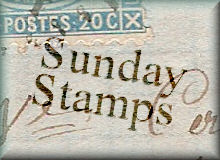
The English translation of the description on the front of this postcard is "In Roslagens arms - the 1977 tourist booklet, published May 2 in celebration of Evert Taube and his poetry." Although he is called a poet on this card, Evert Taube (1890 - 1976) was more of a songwriter and troubadour, and is best known for his folksongs. Roslagen is the name of the coastal areas of Uppland province in Sweden.
The 1977 stamps in this booklet have words and music from one of Taube's popular songs, I Roslagens famn, accompanied by appropriate illustrations. The five lines and approximate translations are, from top to bottom:
The 1977 stamps in this booklet have words and music from one of Taube's popular songs, I Roslagens famn, accompanied by appropriate illustrations. The five lines and approximate translations are, from top to bottom:
Själv blandar jag fredligt mitt kaffe med kron
Of course I mix peacefully my coffee with Crown (rum)
Se måsen med löjan i näbb han
See gull with fish in his beak
Här dansar Calle Schewen med Roslagens mö
Here dancing Calle Schewen (a waltz) with Roslagens maiden
Och vittja tvåhundrade krok
And empty the two hundredth hook (fish hook)
Det brinner i martallens topp!
It burns in the pine trees top!














































